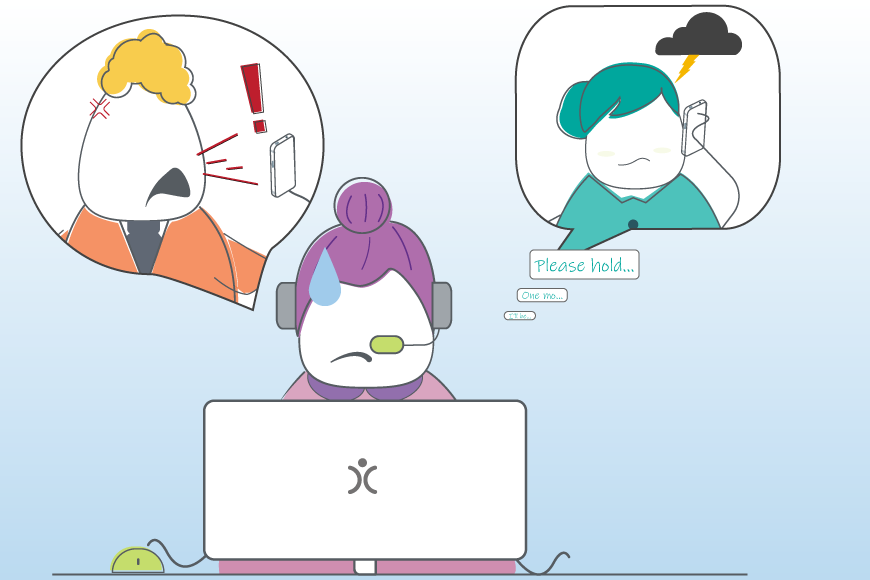Angry Customers and How to Deal with Them
24 Feb 2025
Angry customers are a fact of life. Once you’ve accepted that, you can breathe a sigh of relief and no doubt sleep easier. Their anger may well be justified, whilst being unreasonable on other occasions. Either way, you need to diffuse the situation and work out a solution to placate the client.
If the angry customers are the fire that needs putting out immediately, then as well as dousing those flames you need to consider some longer-term fire prevention. In this article, we’ll be looking at how to manage those heated exchanges and hopefully prevent them in future.
Who is an angry customer?
These can come in all shapes and sizes. If we need to generalise, we could start with the following two broad categories.
Loud and Active
You will all have heard raised voices at the customer service desk, or read complaints on company Facebook pages. No doubt you’ve seen emails from angry customers as well. In these situations, it is usually pretty clear that the client is not happy! If there is one positive here, the problem is usually easy to identify and you can then start to address it. It might be too late to resolve the issue in question, but you can do what you need to placate the customer.
Silent or Passive
Simply because someone does not voice their opinion does not necessarily mean they are happy. If you read between the lines, you may figure out that someone is unhappy without them explicitly saying so. These subtly angry customers can be trickier, as they are less forthcoming about their frustrations. More dangerously, maybe they are expressing their dissatisfaction elsewhere.
As a result, it can be hard to work out how you can make them happy. There are signs to spot an unhappy customer though. If communication with them drops significantly for example. This disengagement could mean various things, including them shopping around for a new supplier. In your CRM, you have the means to track details such as Last Actions, to make sure your accounts don’t go stale.
What has got them so wound up?
For the sake of this article, I’m going to focus on customer who have a genuine issue that needs resolving. Broadly these issues can be broken down into the following categories.
Big Problem
Also known as Code Red! This is when your client experiences serious disruption when using your product or service. Although the problem itself may not be as dramatic as it first seems, you will need to react in a way that the customer deems appropriate. Once you have taken out the sting and removed the immediacy, you could then embark on some educating or fixing to make sure this doesn’t happen again.
Small Problem
If the previous example was a full-on breakdown, this is more like a bump in the road. It won’t require the same immediacy as that code red, but it still needs fixing if you want to put a smile back on your client’s face. In particular you want to avoid the next scenario…
Series of small problems chained together
It is easy to see how this can result in an angry customer, as it seems that nothing works! The good news is that often one problem acts as a catalyst for the rest. Therefore, by tackling the root cause, the rest of the dominoes fall into place. In terms of the angry customer, this is actually an “easy win”.
With issues such as these, it’s worth investigating in the problem at source. Often a scenario like this is down to the customer picking up some bad habits. These could be a result of insufficient training or signposting. But it could also point to documentation that needs reviewing. In either instance this is actually valuable customer feedback as it gives you an opportunity to review procedures and documentation.
One method you could use for troubleshooting is the “Five Whys” technique pioneered by the founder of Toyota, Sakichi Toyoda. Effectively you ask a series of “whys” when a customer presents a problem, until you get to the underlying issue.

Don't just take our word for it
Click to read how other companies have benefited from using OpenCRM. From out-of-the-box implementations to businesses that needed bespoke development to fit their unique approach - we've seen it all.
find out moreHow can you diffuse the situation?
I think there are short and long-term goals to consider here. The short term is to take the heat out of the immediate situation. Your response needs to be in line with the different categories of problem, and the degree of anger the customer is displaying.
Sometimes it can help if the problem is escalated internally. If it means that it lands on the desk of an account manager, it adds weight and send the signal that you are taking the issue seriously. Of course, by using the Helpdesk functionality of a CRM system, you build an audit trail of the challenges faced by each client, and so have some good points of reference if any problem recurs. This video provides an overview of our HelpDesk functionality if that sounds like something you want to start using.
Predicting the Future
You might think the future is impossible to tell, but that is only partially true. You might not know exactly what the weather will be like next Monday, but you do know that the day after Sunday will be Monday. You also know you need to send your customers some information next Monday, and if you don’t do so, there will be problems. Therefore, the future can be considered in terms of factors you can control vs factors you cannot. I’m going to think about these things in context of a SWOT analysis. That means compiling the Strengths, Weaknesses, Opportunities and Threats that present themselves to your business.
Things you can Control
This one is simple – how good is your product? Hopefully this is a strength – you have a great product! But it might also be a weakness, if there are similar products to yours but with more functions for example. If you’ve done your market research, and identified a target audience, you should be able to tell who will benefit the most from your product. Again, this is a strength that you can play to. This also highlights weaknesses and potential flashpoints, if you are accepting customers who might not be your ideal target audience.
Another point within your control is how quick you address problems. This could be a strength or a weakness, depending on your answer. If this is a weakness, it is a likely source of angry customers! Remember, the way a customer experiences your product AND your service is something they will see the overall representation of your company.
Your product documentation may well be a strength or a weakness. However, if you find you get angry customers because they have problems getting to grips with your offering, then it feels like this needs addressing. Hopefully then this is a relatively easy fix to help improve customer satisfaction.
Strengths and Weaknesses can be used to describe where your business and product are at this point in time. For this analysis to be accurate, you need to be honest with yourself. It’s no good telling yourself that your documentation is second to none if you’ve never got an external person to cast a critical eye over it.
Factors you cannot Control
There are lots of elements you cannot control, besides the weather in “sunny” North Yorkshire – more on this in a short while. These factors can present themselves to you as Opportunities or Threats. Here are just a few ideas to get you thinking.
Competitor Activity
This is one you will need to keep a close eye on. Each time a competitor releases a new product, or enhancement to their existing offer, you need to make sure you are keeping up. You might think some of their ideas are good, and some awful, but you do need to make sure you don’t get left behind. This is probably a threat.
Additionally, you may see some companies change their business model. They might decide to discontinue certain product ranges for example. If this gives you more potential space in the market, this is a good Opportunity. If this is the case – have you got the capacity to scale up? Or would you run the risk of spreading yourself too thin, and ultimately creating more angry customers?
Hopefully you can see that the market you are in is never static, and whatever any of the players do is going to impact on the rest of you.
Politics and Economics
These are factors over which you have no control, but you can prepare for eventualities. Say, for example, VAT rates are due to change – you need to make sure your systems are in place to cater for this new taxation.
I mentioned the good old British weather above, so let’s use that as an example. Imagine you are managing an outdoor event in the UK. In order to avoid angry customers, you will need to have plans in place to cover all eventualities. If that sounds like you should consider the weather to be a Threat, it could also be an Opportunity. If the weather is cold and miserable, you could ensure you have a good supply of hot food and drinks to keep people warm and happy. Or if it is a red-hot day (you remember that one we had, in the middle of May?!), a good supply of cold drinks will go down a treat.
Prevention is Better than the Cure
In conclusion, we have seen how angry customers can result from many different factors. Some cannot be helped, and others give you something to learn from. Hopefully you have also seen that many potential problem situations can be pre-empted, and contingency plans put in place for whatever circumstances arise. Whatever happens, the angry customer is unlikely to become a total thing of the past, but wouldn’t it be great if you didn’t see them too often?
My role is to build our Customer Success team and I work with our clients and prospects helping them get the most from their subscription – it is a fun challenging role as no two days are the same. When not in the office I’ll be either making a noise on my guitar or getting my trainers on for a run out in the Yorkshire Dales, North York Moors or the Lake District.